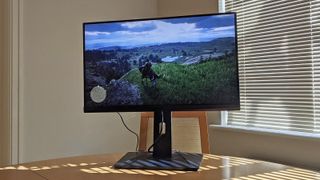The MSI Oculux NXG253R is very much interested in being one of the best gaming monitors around, and it has some impressive tech to help it get there: specifically a 360 Hz refresh rate panel that also offers Nvidia G-Sync support and a 1 ms grey-to-grey response time.
If those words and numbers don't mean much too you, then the MSI Oculux NXG253R gaming monitor might not be the screen for you. It's very much geared towards helping those who are fully into their games and esports, and want a top 1080p experience.
In the detailed MSI Oculux NXG253R review that follows, we'll tell you everything you need to know about how the monitor has been put together and how it works in practice – so you should get a really good idea about whether or not this is the gaming monitor for you.
MSI Oculux NXG253R review: design and setup
The MSI Oculux NXG253R isn't aiming to be the thinnest or lightest monitor around – its main strengths are in other areas – but it's still very well put together, as you would expect from MSI. The bezels around three sizes of the display are pleasingly thin, while the thicker chin features the MSI logo. Around the back there are three USB 3.2 Gen 1 (Type A) ports, one USB 3.2 Gen 1 (Type B) port, one DisplayPort port (version 1.4) and two HDMI ports (version 2.0b) – plenty of connectivity for your peripherals and accessories.
Three of the USB ports are available at the side of the monitor, giving users some extra flexibility, which we appreciate. Even more flexibility is provided with the stand, which lets you tilt and rotate the screen to an impressive extent. It's even possible to turn the display on its side so you can view it in portrait mode, although having the thicker bezel at one side does rather spoil the aesthetics. We'd say the MSI Oculux NXG253R definitely scores full marks in terms of its versatility and the adjustments you can make (it can be VESA mounted as well, if you don't want to use the stand).
You've got some fairly dramatic styling around the back of the monitor, with a big MSI dragon logo, MSI lettering, and a large Nvidia G-Sync 360 sticker as well: we like the angles and bold choices MSI has made here, especially as the backs of monitors are often very drab. Overall, we've got a 24.5-inch screen and full dimensions of 560.1 mm x 399.3 mm x 233.7 mm (that's 22.05 inches x 15.72 inches x 9.20 inches). It weighs in at 6.47 kg or 14.26 lbs – a screen that you can pick up and move fairly easily.
There's a small joystick hidden behind the bottom right corner of the screen giving you control over the various modes and settings on the monitor, and it works rather well, even if it is a bit awkward to access. In terms of setup in general, this is an easy monitor to put together on your own – it's basically just three pieces – but you will need a screwdriver to fix a couple of (included) screws in place, so it's not a fully tool-free installation.
- Here are the best 4K monitors
MSI Oculux NXG253R review: features and picture

The 24.5-inch IPS LCD panel that we have here runs at a resolution of 1,920 x 1,080 pixels, and boasts a jaw-dropping 360 Hz refresh rate – the best you can get at the moment. We've also got support for Nvidia G-Sync and HDR, a 1000:1 contrast ratio, 400 nits of maximum brightness, and a 1 ms grey-to-grey response time. Nvidia's new Reflex Latency Analyzer is supported too, for serious esports competitors who want feedback on their play.
It all adds up to a superb gaming experience that's one of the best we've seen in terms of minimal lag and ghosting. Games such as Red Dead Redemption 2 and Cyberpunk 2077 look crisp and sharp and realistic – although the power of your gaming PC plays a big part here as well of course – and the monitor can quite easily turn its hand to video and general computing as well. If you're willing to trade a compact size in return for super-sharp motion, then you can't do much better than this.
Running everything at up to 360 Hz means a lot of heat, but the extra thickness of the monitor and the upward-pointing vents take care of that – there are no problems with either noise or heat here (there's no fan in the monitor, just heatsinks). We didn't have any issues with switching between inputs and adjusting the on-board settings, though you'll probably want to consult the supplied instruction manual before you start playing around with them.
The MSI Oculux NXG253R gaming monitor is one of several 360 Hz models we've seen in recent times, making use of Fast IPS (or Nano IPS) display technology to give gamers an experience that's a cut above in terms of response and fluidity. We can absolutely confirm that it works superbly well in real life, and the screen won't let you down when it comes to all the other non-gaming tasks you might need to do as well. With the Nvidia G-Sync feature enabled it gets even better, so you'll want to run this monitor with a computer setup that has compatible Nvidia GPUs on board.
- Check out the best gaming monitors
MSI Oculux NXG253R review: price and verdict

The MSI Oculux NXG253R gaming monitor is aimed at quite a specific group of people: serious (perhaps even professional) gamers who want to reduce input lag and display lag to as close to zero as possible. It manages to achieve its goals too, thanks to that 360 Hz refresh rate and the other eye-catching specs on offer here – if you're after silky smooth, fluid gaming action, and you have the connected computer to provide it, then the MSI Oculux NXG253R is a fantastic monitor to pick.
If you're not in that group of people, then the monitor is going to have less appeal – but there's no monitor on the market that can appeal to all different types of users at the same time. You may want more screen space, or a higher resolution, or a thinner form factor rather than super-speedy refresh rates, and that's perfectly fine. The point is that the weaknesses that the MSI Oculux NXG253R has are compromises that have been deliberately chosen by the manufacturer.
There's a lot to like about the monitor besides the headline specs, including the flexibility and versatility that you get with the monitor stand – there aren't many gaming monitors that you can turn on their side and use in portrait mode, so it's another tick in the positives column for this particular model. We also like the broad array of input options here, so connecting up multiple computers and devices is no problem at all.
Check the widgets on this page for the latest prices on the MSI Oculux NXG253R, but at the time of writing the monitor costs about what you would expect, given the tech: in the region of £700 or $600. That's neither appealingly affordable or ridiculously over-the-odds – it's somewhere in the middle (though of course everyone always wants to pay less). If this is a monitor that you're interested in, you might want to keep your eye on how the pricing of it changes over time.
- We've collected together all the best gaming laptops













